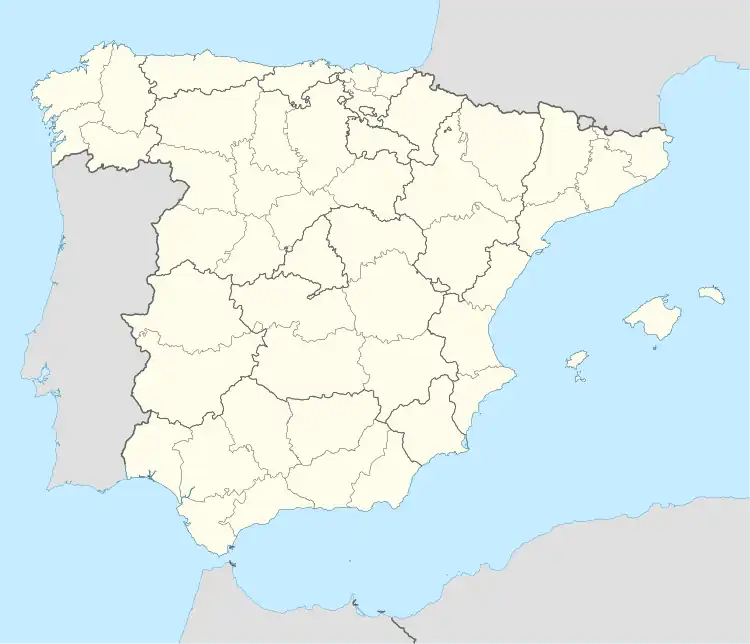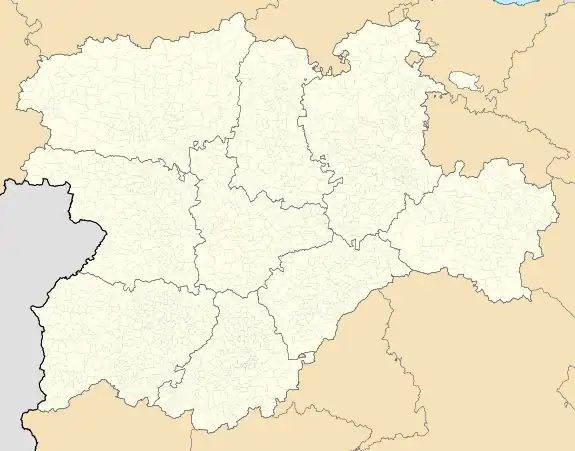Castrojeriz | |
|---|---|
Municipality and town | |
 View of Castrojeriz, 2010 | |
.svg.png.webp) Seal | |
 Castrojeriz Location in Spain  Castrojeriz Castrojeriz (Castile and León) | |
| Coordinates: 42°17′16″N 4°8′20″W / 42.28778°N 4.13889°W | |
| Autonomous community | |
| Province | |
| Comarca | Odra-Pisuerga |
| Founded | 882 |
| Government | |
| • Mayor | Beatriz Francés Pérez |
| Area | |
| • Total | 136 km2 (53 sq mi) |
| Elevation | 804 m (2,638 ft) |
| Population (2018)[1] | |
| • Total | 803 |
| • Density | 5.9/km2 (15/sq mi) |
| Postal code | 09110 |
| Area code | 947 |
| Website | Castrojeriz city council |
Castrojeriz or Castrogeriz is a locality and municipality located in the province of Burgos, in the autonomous community of Castile and León (Spain), the comarca of Odra-Pisuerga, the judicial district of Burgos, head of the town council of the same name and former head of the Castrojeriz judicial district.
It is a popular stop along the French Way of the Camino de Santiago[2] or The Way of Saint James, which crosses the city longitudinally for more than 1,500 meters.[3][4]
History
The village is located along the Odra River just before it joins the Pisuerga. Historically it was head of the Castrojeriz judicial district, one of the fourteen that formed the municipality of Burgos, in the period between 1785 and 1833. In the 1787 Floridablanca Census it fell under the jurisdiction of a lordship with its proprietor being the Marquesa de Camarasa, with an ordinary mayor.

It is believed to have been the former Castrum Sigerici. The village is arranged like other villages along the Camino. On this street-route there are several churches and notable buildings. There is a castle, in ruins, which has a lot of history. The village was established by Count Muño (or Nuño Nuñez), who defended the fort at the end of the ninth century against the Arabs.[4] Before that it had been a Celtiberian, Roman and Visigoth fortress.
In 974, Count García Fernández of Castile granted it a charter, the Charter of Castrojeriz, which is considered to be the 1st granted in Castile.
It is an example of Jacobean urbanism, with houses located around the street-route, which is the longest of all on the pilgrimage route.[4] As an important stage in the Camino de Santiago it had several hospitals along this street.
There is a calvary which sports a Cross of Tau (Tau) instead of the Latin cross perhaps as a reminder of the Order of the Antonians who had a monastery and hospital on the outskirts of the town, where they healed and tended to the sick afflicted by St. Anthony Fire, called also the holy fire, a disease now known to be caused by ingesting a fungal parasite on rye.
Population
As of 1 January 2010 the population of the municipality stood at 882 inhabitants, of which 447 are males and 435 females.[5]
Population by nucleus
| Nucleus | Inhabitants (2000) | Inhabitants (2010)[6] | Notes |
|---|---|---|---|
| Castrojeriz | 600 | 567 | |
| Hinestrosa | 74 | 56 | |
| Tabanera | 0 | 0 | Unpopulated |
| Valbonilla | 72 | 71 | |
| Vallunquera | 63 | 41 | |
| Villasilos | 112 | 103 | |
| Villaveta | 75 | 44 |
Heritage
The village
- Bien de Interés Cultural
- Category: Conjunto histórico (historical group or set)
- Observation: An integral part of the Camino de Santiago delimited by decree 324/99, of the 23 December
- Date — Commencement: 20 December 1974 — Declaration: 20 December 1974 — BOE Declaration: 31 January 1975
The Castle of Castrojeriz

- Bien de Interés Cultural
- Date — Commencement: 22 April 1949 — Declaration: 22 April 1949 — BOE Declaration: 5 May 1949
In 1359 queen Eleanor of Castile, daughter of king Ferdinand IV of Castile and wife of king Alfonso IV of Aragon, was murdered here by order of her nephew Pedro of Castile.
House called "El Fuerte"
- Bien de Interés Cultural
- Date — Commencement: 22 April 1949 — Declaration: 22/04/1949 — BOE Declaration: 5 May 1949
Tower
- Bien de Interés Cultural
- Date — Commencement: 22 April 1949 — Declaration: 22/04/1949 — BOE Declaration: 5 May 1949
Church of San Juan
- Bien de Interés Cultural
- Date — Commencement: 21 November 1980 — Declaration: 29 June 1990 — BOE Declaration: 3 July 1990
The present building was erected for burial of several families of lineage. It contains the following main elements of interest:
- Sixteenth century cloister - Three galleries or pandas still remain. It has a Mudejar style coffered ceiling with astrological references, decorated with the coats of arms of the Gómez Sandovals, who were lords of Castrojeriz between 1426 and 1476. There are some stamped crossings of Templar origin on the capitals of the columns.
- A funeral chapel built by Juan Gonzalez Gallo, located in the south aisle - It is sixteenth century. The altarpiece is composed of 12 panels attributed to Ambrosius Benson.
- Castro-Mujica Chapel, located in the first section of the north aisle - It was built by Juan and Pedro Henestrosa. There is the Gothic interment of Diego Mújica who died in 1527. It is depicted by a recumbent bust and the sarcophagus adorned with his coats of arms.
- The main altarpiece, built of golden pine in the eighteenth century Rococo style. Its construction was ordered by the Knight Commander and Preceptor General of the Order of San Antonio, Damián García Olloqui,[7] for the San Antón Convent in the town, and transferred to the Church of San Juan when the Order of San Antonio was canonically attached to the Order of Malta in 1777 and finally became defunct in 1791.
- It has a choir loft with railings and stairs with Gothic tracery.
Iglesia de Nuestra Señora del Manzano
Ruins of the San Antón convent

Just outside, Castrojeriz on what was formerly the palace and the garden of King Pedro I of Castile, are the ruins of the ancient monastery of San Antón, run by the Hospital Brothers of St. Anthony, who were dedicated to caring for the sick who came along the Camino de Santiago, especially those with the disease called St. Anthony's fire, sacred fire, fire of sick. Currently only the arch that formed a tunnel, through which pilgrims came and went, is left standing.
This monastery was under royal protection, that is why there are royal crests on the front of the church and on the keys of the vaults. It was founded by Alfonso VII in the twelfth century (1146), and was known as the royal xenodoquio of San Antonio Abad.[8] The present ruins are from the fourteenth century. The hospital was very important, because it was the headquarters of the General Commandery of the Order of San Antonio in the various realms of the Crown of Castile and Portugal, with over twenty dependent encomiendas (house-monastery-hospital). The ceremonies that the Anthonian monks held to bless various objects were famous, to which many adherences came. The symbol of the Order was the tau cross.
Famous persons
- Constance of Castile, Duchess of Lancaster (1354-1394) (Castrojeriz, July 1354 - Leicester castle, 24 March 1394). Second daughter of Peter the Cruel, King of Castille, and of María de Padilla, married to John of Gaunt, Duke of Lancaster and third child of king Edward III of England.
- Laín Calvo (Castrojeriz or Castro Xeriz, 798 -? 870 approximately). Supreme judge of Castille.Wikisource
See also
Notes and references
- ↑ Municipal Register of Spain 2018. National Statistics Institute.
- ↑ "Descripción de la Etapa 13 del Camino de Santiago Francés" (in Spanish). Retrieved 18 May 2013.
- ↑ "Camino" (in Spanish). Archived from the original on 11 June 2013. Retrieved 18 May 2013.
- 1 2 3 "Castrojeriz". Retrieved 18 May 2013.
- ↑ "INE: Población por municipios y sexo". Archived from the original on 22 September 2013. Retrieved 18 May 2013.
- ↑ Nomenclátor INE
- ↑ Luciano Huidobro Serna. (1942). Un navarro ilustre. El Comendador mayor don Damián García Olloqui. Príncipe de Viana Magazine.
- ↑ Xenodoquio is the hospital that received foreigners, strangers, such as the pilgrims from Europe along the Camino de Santiago.
Bibliography
- Abásolo Álvarez; José Antonio (1978). Carta arqueológica de la provincia de Burgos: partidos judiciales de Castrojeriz y Villadiego . Diputación Provincial de Burgos, D.L. ISBN 84-7009-061-5.
- Nadal Subías, Eva & Pérez Grijalbo, Rodrigo (2004). Valores naturales del camino de Santiago a su paso por Castrojeriz. Adeco-Camino, D.L. BU-376.- 2004. ISBN 84-96230-04-X.